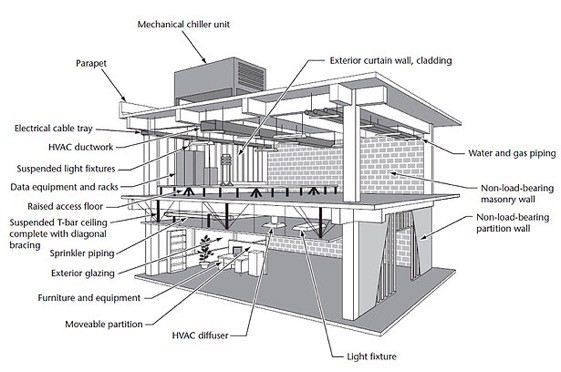Introduction to Non-Structural Elements
For a building to be considered safe during the event of an earthquake, the following conditions need to be fulfilled :
- The people in the building are able to resist the earthquake’s ground motions and no loss of life occurs.
- The contents of the building, along with all the services and utilities are able to resist the impact of the earthquake as well, without any losses.
Therefore, it is essential to ensure that the contents of the building and its services & utilities, together known as Non-Structural Elements (NSE’s) are adequately equipped to resist damage during an Earthquake.
Classification of Non-Structural Elements
NSE’s can be broadly classified into 3 main categories :
- Contents of Building : Includes items that make a space functionally usable. For example – Refrigerators, furniture, door and window frames, storage shelves etc.
- Services & Utilities : Items that ensure the running of essential activities in the building. For example- All kinds of MEP equipment such as Piping, Ducting, Electrical Wiring, Elevators etc.
- Appendages to Buildings : Items attached to the exterior surface of a building such as chimneys, facades, antennas and advertisement hoardings.

Image : Examples of NSE’s in Building
Cost Implications of Non-Structural Elements in Buildings
Today, already about 60-70% of the total cost of construction in new buildings being built in urban India is of NSEs, and the rest of the SEs. Since NSEs account for significant part of the total cost of most buildings, it is recognised in countries prone to seismic hazard, that good earthquake performance of NSEs also is extremely important.

The share of cost of NSEs has been rising out of the building construction cost of the project over the last four decades in India. From a meagre 5% in the 1970s, cost of NSEs rose to a dominant ~70% in the 2000s with high expectations of functional performance of buildings and increased maintenance costs.

Fig : Evolution trends in costs of NSEs used in buildings over the last four decades: in India and in countries with advanced seismic provisions for design of buildings and NSEs
Source : https://www.iitk.ac.in/nicee/IITK-GSDMA/NSE_002_31May2013.pdf
Fig : Percentage Cost distribution of components in building
Importance of Securing NSE’s
Past earthquake experiences have shown that negligence to secure non-structural elements in building can lead to multiple negative effects such as :
- Primary hazard : when the damage to the NSE can impair its own function and cause a threat to people’s lives in the building.
- Secondary hazard :when the NSE can cause an action that may lead to loss of life, property and loss of building functionality. An example of the same is damage to piping which leads to leakage of water, flooding the building and eventually shutting down the electricity, thus making the building unusable.
Therefore, it is in the interest of all stakeholders of the building, namely consultants, architects, owners, contractors and manufacturers to come together to ensure all safety measures are taken for seismic protection of NSE’s.
Lack of awareness on the topic has causes significant losses in urban buildings in recent times. Thus, it is important to emphasise the importance of securing NSE’s through a joint effort which involves creating a legal framework for the same, as well as identifying advanced safety practises instilled by other countries and implementing them.
Source : https://www.iitk.ac.in/nicee/IITK-GSDMA/NSE_002_31May2013.pdf
